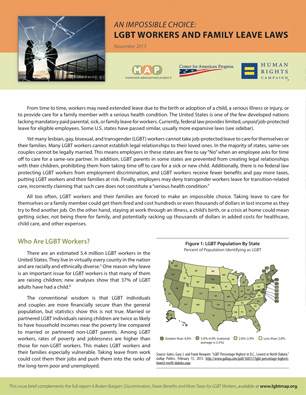The Bottom Line
An Impossible Choice: LGBT Workers and Family Leave Laws highlights how discriminatory laws and unequal access to family and medical leave laws force lesbian, gay, bisexual, and transgender workers to choose between managing medical or family crises and holding onto their jobs and their livelihoods.
Workers may need extended leave due to the birth or adoption of a child, a serious illness or injury, or to provide care for a family member with a serious medical condition. Yet, in the 34 states where same-sex couples cannot marry, LGBT families are often denied equal access to job-protected leave and face added obstacles to managing such situations. Transgender workers may confront challenges getting job-protected leave for their own transition-related care.
When taking leave due to a medical or family crisis, LGBT workers risk losing their jobs, which could cost them hundreds or even thousands of dollars in lost income. On the other hand, staying at work through an illness, a child’s birth, or a crisis at home could mean getting sicker, not being there for their families, and potentially racking up thousands of dollars in added costs for healthcare, child care, and other expenses.
An Impossible Choice: LGBT Workers and Family Leave Law examines the precarious circumstances LGBT people navigate and offers includes common-sense policy recommendations.
An Impossible Choice: LGBT Workers and Family Leave Laws Download
Recommended citation:
Movement Advancement Project, Center for American Progress, and Human Rights Campaign. November 2013.
An Impossible Choice: LGBT Workers and Family Leave Laws.
https://www.lgbtmap.org/family-leave (date of access).


